Opening and Closure of the Sulu Sea: Revealed by Its Peripheral Subduction and Collision Processes
Abstract
:1. Introduction

2. Tectonic Setting
2.1. Proto-South China Sea Subduction-Collision
2.2. Borneo Rotated Counterclockwise and Sabah Orogeny
2.3. NW Philippine Sea Plate Subduction
2.4. Celebes Sea Subduction
3. Sulu Sea Tectonic and Sedimentary Comparison
3.1. Subduction-Collision Tectonic Zone in Northern Margins of the Sulu Sea
3.1.1. Sabah-Nansha Block Collision Zone
3.1.2. SW Palawan-Cagayan Arc Collision Zone
3.1.3. NW Palawan-Mindoro Arc Collision Zone
3.2. Subduction Tectonic Zone in Southern and Eastern Margins of the Sulu Sea
3.2.1. SE Sulu Sea Southward Subduction Zone
3.2.2. SE Sulu Sea Southeastward Subduction Zone
4. Discussion
4.1. Evolution of Sulu Sea Arc–Basin System
4.2. Plate Tectonic Evolution Pattern
4.3. Implications on the Dynamics of Adjacent Marginal Seas of the Sulu Sea
5. Conclusions
- The northern margins can be divided into three tectonic zones: the Sabah-Nansha Block collision zone in NE Borneo, the SW Palawan-Cagayan arc collision zone in SW Palawan Island, and NW Palawan-Mindoro arc collision zone. Furthermore, the southeastern margins can also be divided into two tectonic zones: the SE Sulu Sea southward subduction zone and SE Sulu Sea southeastward subduction zone. Each tectonic zone exhibits unique structural styles and sedimentary response characteristics.
- The northern margins of the Sulu Sea have undergone multiple dynamic processes including the subduction and collision of different microblocks. These processes have led to the opening of the Sulu Sea from west to east. Meanwhile, the southeastern margins of the Sulu Sea are characterized by the subduction of the SE Sulu Sea crust and ocean-arc collision, leading to the closure of the Sulu Sea from south to east.
- The Sulu Sea and its adjacent marginal seas feature multiple and intricate subduction dynamic systems. Due to insufficient data and the complexity of regional tectonic dynamics, there are still many contradictions and uncertainties in the explanations (such as the SE Sulu Sea southward subduction zone). It is reasonable to believe that with additional data supplementation, the dynamics of multiple microplates in Southeast Asia will be interpreted more accurately.
Author Contributions
Funding
Institutional Review Board Statement
Informed Consent Statement
Data Availability Statement
Acknowledgments
Conflicts of Interest
References
- Hall, R. Cenozoic geological and plate tectonic evolution of SE Asia and the SW Pacific: Computer-based reconstructions, model and animations. J. Asian Earth Sci. 2002, 20, 353–431. [Google Scholar] [CrossRef]
- Hall, R. Late Jurassic-Cenozoic reconstructions of the Indonesian region and the Indian Ocean. Tectonophysics 2012, 570–571, 1–41. [Google Scholar] [CrossRef]
- Pubellier, M.; Morley, C.K. The basins of Sundaland (SE Asia): Evolution and boundary conditions. Mar. Petrol. Geol. 2014, 58, 555–578. [Google Scholar] [CrossRef]
- Jamil, M.; Siddiqui, N.A.; Ahmed, N.; Usman, M.; Umar, M.; Rahim, H.U.; Imran, Q.S. Facies Analysis and Sedimentary Architecture of Hybrid Event Beds in Submarine Lobes: Insights from the Crocker Fan, NW Borneo, Malaysia. J. Mar. Sci. Eng. 2021, 9, 1133. [Google Scholar] [CrossRef]
- Jamil, M.; Siddiqui, N.A.; Rahman, A.H.B.A.; Ibrahim, N.A.; Ismail, M.S.B.; Ahmed, N.; Usman, M.; Gul, Z.; Imran, Q.S. Facies Heterogeneity and Lobe Facies Multiscale Analysis of Deep-Marine Sand-Shale Complexity in the West Crocker Formation of Sabah Basin, NW Borneo. Appl. Sci. 2021, 11, 5513. [Google Scholar] [CrossRef]
- Jamil, M.; Siddiqui, N.A.; Umar, M.; Usman, M.; Ahmed, N.; Abd Rahman, A.H.; Zaidi, F.K. Aseismic and seismic impact on development of soft-sediment deformation structures in deep-marine sand-shaly Crocker fan in Sabah, NW Borneo. J. King Saud Univ. Sci. 2021, 33, 101522. [Google Scholar] [CrossRef]
- Villenuve, M.; Rehault, J.P.; Cornee, J.J.; Honthaas, C.; Gunawan, W.; the GEOBANDA Group. The main steps of the Geodynamic evolution of Eastern Indonesia since upper Miocene. In “The Geodynamics of S and SE Asia” Scientific Technical Report of Geodyssea Symposium (Penang, Malaysia, 1997); Wilson, P., Michel, G., Eds.; GFZ: Potsdam, Germany, 1998; pp. 264–275. [Google Scholar]
- Zaw, K.; Meffre, S.; Lai, C.K.; Burrett, C.; Santosh, M.; Graham, I.; Manaka, T.; Salam, A.; Kamvong, T.; Cromie, P. Tectonics and metallogeny of mainland Southeast Asia—A review and contribution. Gondwana Res. 2014, 26, 5–30. [Google Scholar] [CrossRef]
- Advokaat, E.L.; Marshall, N.T.; Li, S.; Spakman, W.; Krijgsman, W.; van Hinsbergen, D.J.J. Cenozoic rotation history of Borneo and Sundaland, SE Asia revealed by paleomagnetism, seismic tomography, and kinematic reconstruction. Tectonics 2018, 37, 2486–2512. [Google Scholar] [CrossRef]
- Rangin, C. The Sulu Sea, a back-arc basin setting within a Neogene collision zone. Tectonophysics 1989, 161, 119–141. [Google Scholar] [CrossRef]
- Rangin, C.; Silver, E. Geological setting of the Celebes and Sulu Seas. In Proceedings of the Ocean Drilling Program, Initial Reports; Ocean Drilling Program; Texas A&M University: College Station, TX, USA, 1990; Volume 124. [Google Scholar] [CrossRef]
- Hutchison, C.S. The Southeast Sulu Sea, a Neogene marginal basin with outcropping extensions in Sabah. Bull. Geol. Soc. Malays. 1992, 32, 89–108. [Google Scholar] [CrossRef]
- Lai, C.K.; Xia, X.P.; Hall, R.; Meffre, S.; Tsikouras, B.; Balangue-Tarriela, M.I.R.; Idrus, A.; Ifandi, E.; Norazme, N. Cenozoic evolution of the Sulu Sea arc-basin system: An overview. Tectonics 2021, 40, e2020TC006630. [Google Scholar] [CrossRef]
- Hall, R.; Breitfeld, H.T. Nature and demise of the Proto-South China Sea. Bull. Geol. Soc. Malays. 2017, 63, 61–76. [Google Scholar] [CrossRef]
- Schlüter, H.U.; Hinz, K.; Block, M. Tectono-stratigraphic terranes and detachment faulting of the South China Sea and Sulu Sea. Mar. Geol. 1996, 130, 39–78. [Google Scholar] [CrossRef]
- Liu, W.N.; Li, C.F.; Li, J.B.; Fairhead, D.; Zhou, Z.Y. Deep structures of the Palawan and Sulu Sea and their implications for opening of the South China Sea. Mar. Petrol. Geol. 2014, 58, 721–735. [Google Scholar] [CrossRef]
- Shao, L.; Cao, L.C.; Qiao, P.J.; Zhang, X.T.; Li, Q.Y.; van Hinsbergen, D.J.J. Cretaceous–Eocene provenance connections between the Palawan Continental Terrane and the northern South China Sea margin. Earth Planet. Sci. Lett. 2017, 477, 97–107. [Google Scholar] [CrossRef]
- Sandal, S.T. The Geology and Hydrocarbon Resources of Negara Brunei Darussalam; Brunei Shell Petroleum/Brunei Museum: Syabas Bandar Seri Begawan, Brunei Darussalam, 1996. [Google Scholar]
- Hesse, S.; Back, S.; Franke, D. The deep-water fold-and-thrust belt offshore NW Borneo: Gravity-driven versus basement-driven shortening. Geol. Soc. Am. Bull. 2009, 121, 939–953. [Google Scholar] [CrossRef]
- Hutchison, C.S. The North-West Borneo Trough. Mar. Geol. 2010, 271, 32–43. [Google Scholar] [CrossRef]
- Hall, R. Contraction and extension in northern Borneo driven by subduction rollback. J. Asian Earth Sci. 2013, 76, 399–411. [Google Scholar] [CrossRef]
- Bacon, C.A.; Rawlinson, N.; Pilia, S.; Gilligan, A.; Wehner, D.; Cornwell, D.G.; Tongkul, F. The signature of lithospheric anisotropy at post-subduction continental margins: New insight from XKS splitting analysis in northern Borneo. Geochem. Geophy. Geosy. 2022, 23, e2022GC010564. [Google Scholar] [CrossRef]
- Bellon, H.; Rangin, C. Geochemistry and isotopic dating of Cenozoic volcanic arc sequences around the Celebes and Sulu Seas. In Proceedings of the Ocean Drilling Program, Scientific Results; Ocean Drilling Program; Texas A&M University: College Station, TX, USA, 1991; Volume 124, pp. 321–338. [Google Scholar] [CrossRef]
- Rangin, C.; Silver, E. Neogene Tectonic evolution of the Celebes-Sulu Basins: New Insights from Leg 124 Drilling. In Proceedings of the Ocean Drilling Program, Scientific Results; Ocean Drilling Program; Texas A&M University: College Station, TX, USA, 1991; Volume 124. [Google Scholar] [CrossRef]
- Schlüter, H.U.; Block, M.; Hinz, K.; Neben, S.; Seidel, D.; Djajadihardja, Y. Neogene sediment thickness and Miocene basin-floor fan systems of the Celebes Sea. Mar. Petrol. Geol. 2001, 18, 849–861. [Google Scholar] [CrossRef]
- Holloway, N.H. The north Palawan block, Philippines: Its relation to the Asian mainland and its role in the evolution of the South China Sea. Geol. Soc. Malays. Bull. 1981, 14, 19–58. [Google Scholar] [CrossRef]
- Pubellier, M.; Quebral, R.; Rangin, C.; Deffontaines, B.; Muller, C.; Butterlin, J.; Manzano, J. The Mindanao collision zone: A soft collision event within a continuous Neogene strike-slip setting. J. Southeast Asian Earth Sci. 1991, 6, 239–248. [Google Scholar] [CrossRef]
- Sajona, F.G.; Maury, R.; Prouteau, G.; Cotten, J.; Schiano, P.; Bellon, H.; Fontaine, L. Slab melt as metasomatic agent in island arc magma mantle sources, Negros and Batan (Philippines). Isl. Arc 2000, 9, 472–486. [Google Scholar] [CrossRef]
- Ozawa, A.; Tagami, T.; Listanco, E.L.; Arpa, C.B.; Sudo, M. Initiation and propagation of subduction along the Philippine Trench: Evidence from the temporal and spatial distribution of volcanoes. J. Asian Earth Sci. 2004, 23, 105–111. [Google Scholar] [CrossRef]
- Mascle, A.; Biscarrat, P.A. The Sulu Sea: A marginal sea in Southeast Asia. In Geological and Geophysical Investigations of Continental Margins; Watkins, J.S., Montadert, L., Dickerson, P.W., Eds.; AAPG Memoir; GeoScienceWorld: McLean, VA, USA, 1978; Volume 29, pp. 373–381. [Google Scholar] [CrossRef]
- Advokaat, E.L.; van Hinsbergen, D.J.J. Finding Argoland: Reconstructing a microcontinental archipelago from the SE Asian accretionary orogen. Gondwana Res. 2024, 128, 161–263. [Google Scholar] [CrossRef]
- Hutchison, C.S. Marginal basin evolution: The southern South China Sea. Mar. Petrol. Geol. 2004, 21, 1129–1148. [Google Scholar] [CrossRef]
- GEBCO Compilation Group. GEBCO 2020 Grid (Gridded Bathymetry Data Download). 2020. Available online: https://download.gebco.net (accessed on 30 October 2023).
- Pubellier, M.; Aurelio, M.; Sautter, B. The life of a marginal basin depicted in a structural map of the South China Sea. Episodes 2018, 41, 139–142. [Google Scholar] [CrossRef]
- Bonvalot, S.; Briais, A.; Kuhn, M.; Peyrefitte, A.; Vales, N.; Biancale, R.; Gabalda, G.; Moreaux, G.; Reinquin, F.; Sarrailh, M. Global Grids: World Gravity Map (WGM2012); Bureau Gravimetrique International: Toulouse, France, 2012. [Google Scholar] [CrossRef]
- Lourens, L.J.; Hilgen, F.J.; Shackleton, N.J.; Laskar, J.; Wilsonet, D. The Neogene Period. In A Geologic Time Scale; Gradstein, F.M., Ogg, J.G., Smith, A.G., Eds.; Cambridge University Press: Cambridge, UK, 2004; pp. 409–440. [Google Scholar]
- Haq, B.U.; Hardenbol, J.; Vail, P.R. Chronology of Fluctuating Sea Levels since the Triassic. Science 1987, 235, 1156–1167. [Google Scholar] [CrossRef]
- Hinz, K.; Block, M.; Kudrass, H.R.; Meyer, H. Structural elements of the Sulu Sea, Philippines. AAPG Bull. 1991, 78, 483–506. [Google Scholar]
- Zhao, J.; Zhang, L.; Wang, X.Y.; Ge, J.L.; Xu, M.; Chen, W.; Luo, M.; Liang, Q.Y.; Yu, Q.H.; Luo, S.B.; et al. Characteristics of Paleontological Communities in Surface Sediments of the Southern South China Sea and Their Paleoclimatic and Paleoenvironmental Significance. J. Earth Sci. 2024, 35, 144–154. [Google Scholar] [CrossRef]
- Wang, Y.Y.; Zhao, Y.H.; Ding, W.W.; Fang, P.G.; Li, J.B. Cenozoic Propagated Rifting in the Dangerous Grounds in Response to the Episodic Seafloor Spreading of the South China Sea. J. Earth Sci. 2022, 33, 1031–1046. [Google Scholar] [CrossRef]
- Yumul, G.P.; Dimalanta, C.B.; Marquez, E.J.; Queaño, K.L. Onland signatures of the Palawan microcontinental block and Philippine mobile belt collision and crustal growth process: A review. J. Asian Earth Sci. 2009, 34, 610–623. [Google Scholar] [CrossRef]
- Fan, J.K.; Zhao, D.P. Evolution of the southern segment of the Philippine Trench: Constraints from seismic tomography. Geochem. Geophys. Geosyst. 2018, 19, 4612–4627. [Google Scholar] [CrossRef]
- Xie, X.N.; Zhao, S.; Ren, J.Y.; Yang, Y.L.; Yao, Y.J. Marginal Sea Closure Process and Genetic Mechanism of South China Sea during Post-Spreading Period. Earth Sci. 2022, 47, 3524–3542, (In Chinese with English abstract). [Google Scholar] [CrossRef]
- Xie, X.J.; Tang, W.; Zhang, G.C.; Zhao, Z.G.; Song, S.; Guo, J. The gradual subduction-collision evolution model of Proto-South China Sea and its control on oil and gas. Acta Oceanol. Sin. 2023, 42, 123–137. [Google Scholar] [CrossRef]
- Fuller, M.; Ali, J.R.; Moss, S.J.; Frost, G.M.; Richter, B.; Mahfi, A. Paleomagnetism of Borneo. J. Asian Earth Sci. 1999, 17, 3–24. [Google Scholar] [CrossRef]
- Hennig-Breitfeld, J.; Breitfeld, H.T.; Hall, R.; BouDagher-Fadel, M.; Thirlwall, M. A new upper Paleogene to Neogene stratigraphy for Sarawak and Labuan in north-western Borneo: Paleogeography of the eastern Sundaland margin. Earth-Sci. Rev. 2019, 190, 1–32. [Google Scholar] [CrossRef]
- Hutchison, C.S. The ‘Rajang Accretionary Prism’ and ‘Lupar Line’ Problem of Borneo. Geol. Soc. Lond. Spec. Publ. 1996, 106, 247–261. [Google Scholar] [CrossRef]
- Jamil, M.; Siddiqui, N.A.; Usman, M.; Wahid, A.; Umar, M.; Ahmed, N.; Ul Haq, I.; El-Ghali, M.A.K.; Imran, Q.S.; Abd Rahman, A.H.; et al. Facies analysis and distribution of Late Palaeogene deep-water massive sandstones in submarine-fan lobes, NW Borneo. Geol. J. 2022, 57, 4489–4507. [Google Scholar] [CrossRef]
- Jackson, C.A.L.; Zakaria, A.A.; Johnson, H.D.; Tongkul, F.; Crevello, P.D. Sedimentology, stratigraphic occurrence and origin of linked debrites in the West Crocker Formation (Oligo-Miocene), Sabah, NW Borneo. Mar. Petrol. Geol. 2009, 26, 1957–1973. [Google Scholar] [CrossRef]
- Lunt, P. Discussion on: A new upper Paleogene to Neogene stratigraphy for Sarawak and Labuan in northwestern Borneo: Paleogeography of the eastern Sundaland margin. Earth-Sci. Rev. 2019, 202, 102980. [Google Scholar] [CrossRef]
- van Hattum, M.W.A.; Hall, R.; Pickard, A.L.; Nichols, G.J. Provenance and Geochronology of Cenozoic Sandstones of Northern Borneo. J. Asian Earth Sci. 2013, 76, 266–282. [Google Scholar] [CrossRef]
- Jamil, M.; Abd Rahman, A.H.; Siddiqui, N.A.; Ibrahim, N.A.; Ahmed, N. A contemporary review of sedimentological and stratigraphic framework of the Late Paleogene deep marine sedimentary successions of West Sabah, North-West Borneo. Bull. Geol. Soc. Malays. 2020, 69, 53–65. [Google Scholar] [CrossRef]
- Cullen, A.; Reemst, P.; Henstra, G.; Gozzard, S.; Ray, A. Rifting of the South China Sea: New Perspectives. Petrol. Geosci. 2010, 16, 273–282. [Google Scholar] [CrossRef]
- Cullen, A. Nature and Significance of the West Baram and Tinjar Lines, NW Borneo. Mar. Petrol. Geol. 2014, 51, 197–209. [Google Scholar] [CrossRef]
- Steuer, S.; Franke, D.; Meresse, F.; Savva, D.; Pubellier, M.; Auxietre, J.L. Oligocene-Miocene carbonates and their role for constraining the rifting and collision history of the Dangerous Grounds, South China Sea. Mar. Petrol. Geol. 2014, 58, 644–657. [Google Scholar] [CrossRef]
- Simons, W.J.F.; Socquet, A.; Vigny, C.; Ambrosius, B.A.C.; Haji Abu, S.; Promthong, C.; Subarya, C.; Sarsito, D.A.; Matheussen, S.; Morgan, P.; et al. A decade of GPS in Southeast Asia: Resolving Sundaland motion and boundaries. J. Geophys. Res. 2007, 112, B06420. [Google Scholar] [CrossRef]
- Greenfield, T.; Gilligan, A.; Pilia, S.; Cornwell, D.G.; Tongkul, F.; Widiyantoro, S.; Rawlinson, N. Post-subduction tectonics of Sabah, northern Borneo, inferred from surface wave tomography. Geophys. Res. Lett. 2022, 49, e2021GL096117. [Google Scholar] [CrossRef]
- Linang, H.T.; Pilia, S.; Rawlinson, N.; Bacon, C.A.; Gilligan, A.; Cornwell, D.G.; Tongkul, F. Collision-induced subduction polarity reversal explains the crustal structure of northern Borneo: New results from Virtual Deep Seismic Sounding (VDSS). Geophys. Res. Lett. 2022, 49, e2022GL099123. [Google Scholar] [CrossRef]
- Pilia, S.; Davies, D.R.; Hall, R.; Bacon, C.A.; Gilligan, A.; Greenfield, T.; Tongkul, F.; Kramer, S.C.; Wilson, C.R.; Ghelichkhan, S.; et al. Post-subduction tectonics induced by extension from a lithospheric drip. Nat. Geosci. 2023, 16, 646–652. [Google Scholar] [CrossRef]
- Northrup, C.J.; Royden, L.H.; Burchfiel, B.C. Motion of the Pacific plate relative to Eurasia and its potential relation to Cenozoic extension along the eastern margin of Eurasia. Geology 1995, 23, 719–722. [Google Scholar] [CrossRef]
- Aurelio, M.A.; Forbes, M.T.; Taguibao, K.J.L.; Savella, R.B.; Bacud, J.A.; Franke, D.; Pubellier, M.; Savva, D.; Meresse, F.; Steuer, S.; et al. Middle to Late Cenozoic tectonic events in south and central Palawan (Philippines) and their implications to the evolution of the south-eastern margin of South China Sea: Evidence from onshore structural and offshore seismic data. Mar. Petrol. Geol. 2014, 58, 658–673. [Google Scholar] [CrossRef]
- Sibuet, J.C.; Zhao, M.; Wu, J.; Lee, C.S. Geodynamic and plate kinematic context of South China Sea subduction during Okinawa trough opening and Taiwan orogeny. Tectonophysics 2021, 817, 229050. [Google Scholar] [CrossRef]
- Yumul, G.P.; Dimalanta, C.B.; Maglambayarw, V.B.; Marquez, E.J. Tectonic setting of a composite terrane: A review of the Philippine island arc system. Geosci. J. 2008, 12, 7–17. [Google Scholar] [CrossRef]
- Mitchell, A.H.G.; Hernandez, F.; de la Cruz, A.P. Cenozoic evolution of the Philippine Archipelago. J. Southeast Asian Earth Sci. 1986, 1, 3–22. [Google Scholar] [CrossRef]
- Aurelio, M.A.; Peña, R.E.; Taguibao, K.J.L. Sculpting the Philippine archipelago since the Cretaceous through rifting, oceanic spreading, subduction, obduction, collision and strike-slip faulting: Contribution to IGMA5000. J. Asian Earth Sci. 2013, 72, 102–107. [Google Scholar] [CrossRef]
- Casulla, M.A.A.; Mizunaga, H.; Tanaka, T.; Dimalanta, C.B. Imaging crustal features and Moho depths through enhancements and inversion of gravity data from the Philippine island arc system. Prog. Earth Planet. Sci. 2022, 9, 16. [Google Scholar] [CrossRef]
- Gaina, C.; Müller, D. Cenozoic tectonic and depth/age evolution of the Indonesian gateway and associated back-arc basins. Earth-Sci. Rev. 2007, 83, 177–203. [Google Scholar] [CrossRef]
- Bergman, S.; Hutchison, C.; Swauger, D.; Graves, J. K:Ar ages and geochemistry of the Sabah Cenozoic volcanic rocks. Bull. Geol. Soc. Malays. 2000, 44, 165–171. [Google Scholar] [CrossRef]
- Silver, E.A.; Mccaffrey, R.; Smith, R.B. Collision, rotation, and the initiation of subduction in the evolution of Sulawesi, Indonesia. J. Geophys. Res. 1983, 88, 9407–9418. [Google Scholar] [CrossRef]
- Rangin, C.; Spakman, W.; Pubellier, M.; Bijwaard, H. Tomographic and geological constraints on subduction along the eastern Sundaland continental margin (South-East Asia). Bull. Société Géologique Fr. 1999, 170, 775–788. [Google Scholar]
- Beck, R.A.; Burbank, D.W.; Sercombe, W.J.; Khan, A.M.; Lawrence, R.D. Late Cretaceous ophiolite obduction and Paleocene India-Asia collision in the westernmost Himalaya. Geodin. Acta 1996, 9, 114–144. [Google Scholar] [CrossRef]
- Shi, H.; Ding, W.F.; Yin, S.R.; Gao, J.Y.; Li, J.B. Erosion-Dominated Modern Submarine Gully-Canyon-Channel Systems in Offshore Northwest Palawan, Southern South China Sea. J. Earth Sci. 2023, in press. [Google Scholar]
- Hutchison, C.S.; Bergman, S.C.; Swauger, D.A.; Graves, J.E. A Miocene Collisional Belt in North Borneo: Uplift Mechanism and Isostatic Adjustment Quantified by Thermochronology. J. Geol. Soc. Lond. 2000, 157, 783–793. [Google Scholar] [CrossRef]
- Hamilton, W.B. Tectonics of the Indonesian Region. Bull. Geol. Soc. Malays. 1973, 6, 3–10. [Google Scholar] [CrossRef]
- Luo, X.G.; Wang, W.Y.; Zhang, G.C.; Zhao, Z.G.; Liu, J.L.; Xie, X.J.; Qiu, Z.Y.; Feng, X.L.; Ji, X.L.; Wang, D.D. Study on distribution features of faults based on gravity data in the South China Sea and its adjacent areas. Chin. J. Geophys. 2018, 61, 4255–4268. [Google Scholar] [CrossRef]
- Balaguru, A.; Nichols, G. Tertiary Stratigraphy and Basin Evolution, Southern Sabah (Malaysian Borneo). J. Asian Earth Sci. 2004, 23, 537–554. [Google Scholar] [CrossRef]
- Zhu, C.X.; Tang, W.; Yin, Y.K.; Song, S.; He, K.L.; Tang, H.F. Characteristics and formation mechanism of regional faults system in southern South China Sea and continental margins. Glob. Geol. 2019, 38, 708–720, (In Chinese with English abstract). [Google Scholar] [CrossRef]
- Hinz, K.; Schlüter, H.U. Geology of the Dangerous Grounds, South China Sea, and the continental margin off southwest Palawan: Results of SONNE cruises SO-23 and SO-27. Energy 1985, 10, 297–315. [Google Scholar] [CrossRef]
- Morley, C.K.; King, R.; Hillis, R.; Tingay, M.; Backe, G. Deepwater Fold and Thrust Belt Classification, Tectonics, Structure and Hydrocarbon Prospectivity: A Review. Earth-Sci. Rev. 2011, 104, 41–91. [Google Scholar] [CrossRef]
- Wang, L.J.; Yao, Y.J.; Sun, Z.; Li, F.C.; Yang, C.P.; Xu, Z.Y. The discrimination of Mesozoic sequence and its tectonic attribute in the southeastern South China Sea. Geol. China 2020, 47, 1337–1354, (In Chinese with English abstract). [Google Scholar]
- Steuer, S.; Franke, D.; Meresse, F.; Savva, D.; Pubellier, M.; Auxietre, J.L.; Aurelio, M. Time Constraints on the Evolution of Southern Palawan Island, Philippines from Onshore and Offshore Correlation of Miocene Limestones. J. Asian Earth Sci. 2013, 76, 412–427. [Google Scholar] [CrossRef]
- Wang, L.J.; Yao, Y.J.; Sun, Z.; Zhuo, H.T.; Zhao, Z.X.; Yin, Z.X. Characteristics of Interface S3 (the End of Middle Miocene) on the Southeast South China Sea Margin and Its Geological Implications. Mar. Geol. Quat. Geol. 2019, 39, 75–86, (In Chinese with English abstract). [Google Scholar] [CrossRef]
- Cadenas, P.; Ranero, C.R. Structure and tectonic evolution of the NW Sulu Sea Basin (SE Asia). J. Geophys. Res. Solid Earth 2024, 129, e2022JB026180. [Google Scholar] [CrossRef]
- Yumul, G.P.; Dimalanta, C.B.; Tamayo, R.A. Indenter-Tectonics in the Philippines: Example from the Palawan Microcontinental Block-Philippine Mobile Belt Collision. Resour. Geol. 2005, 55, 189–198. [Google Scholar] [CrossRef]
- Wu, J.; Suppe, J.; Lu, R.Q.; Kanda, R. Philippine Sea and East Asian Plate Tectonics since 52 Ma Constrained by New Subducted Slab Reconstruction Methods. J. Geophys. Res.-Solid Earth 2016, 121, 4670–4741. [Google Scholar] [CrossRef]
- Murauchi, S.; Ludwig, W.J.; Den, N.; Hotta, H.; Asanuma, T.; Yoshii, T.; Kubotera, A.; Hagiwaraet, K. Structure of the Sulu Sea and the Celebes Sea. J. Geophys. Res. 1973, 78, 3437–3447. [Google Scholar] [CrossRef]
- Roeser, H.A. Age of the crust of the southeast Sulu Sea basin based on magnetic anomalies and age determined at Site 768. In Proceedings of the Ocean Drilling Program, Initial Reports; Ocean Drilling Program; Texas A&M University: College Station, TX, USA, 1991; Volume 124, pp. 339–343. [Google Scholar] [CrossRef]
- Shyu, J.P.; Merrill, D.; Hsu, V.; Kaminski, M.A.; Muller, C.M.; Nederbragt, A.J.; Scherer, R.P. Biostratigraphic and magnetostratigraphic synthesis of the Celebes and Sulu Seas, Leg 124. In Proceedings of the Ocean Drilling Program, Scientific Results; Ocean Drilling Program; Texas A&M University: College Station, TX, USA, 1991; Volume 124, pp. 11–38. [Google Scholar] [CrossRef]
- Kudrass, H.R.; Müller, P.; Kreuzer, H.; Weiss, W. Volcanic rocks and tertiary carbonates dredged from the Cagayan Ridge and the Southwest Sulu Sea, Philippines. In Proceedings of the Ocean Drilling Program, Part A: Initial Reports; Ocean Drilling Program; Texas A&M University: College Station, TX, USA, 1990; Volume 124, pp. 93–100. [Google Scholar]
- Spadea, P.; Beccaluva, L.; Civetta, L.; Coltorti, M.; Dostal, J.; Sajona, F.; Serri, G.; Vaccaro, C.; Zeda, O. Petrology of basic igneous rocks from the floor of the Sulu Sea. In Proceedings of the Ocean Drilling Program, Scientific Results; Ocean Drilling Program; Texas A&M University: College Station, TX, USA, 1991; Volume 124, pp. 251–269. [Google Scholar]
- Tsikouras, B.; La, C.K.; Ifandi, E.; Norazme, N.A.; Teo, C.H.; Xia, X.P. New zircon radiometric U-Pb ages and Lu-Hf isotopic data from the ultramafic-mafic sequences of Ranau and Telupid (Sabah, eastern Malaysia): Time to reconsider the geological evolution of Southeast Asia? Geology 2021, 49, 789–793. [Google Scholar] [CrossRef]
- Haile, N.; Wong, N. The Geology and Mineral Resources of the Dent Peninsula, Sabah, Malaysia: Borneo Reg. Borneo Reg. Malays. Geol. Surv. Mem. 1965, 16, 1–99. [Google Scholar]
- Yumul, G.P.; Dimalanta, C.; Tamayo, R.A.; Maury, R.; Bellon, H.; Polvé, M.; Maglambayan, V.B.; Querubin, C.L.; Cotten, J. Geology of the Zamboanga Peninsula, Mindanao, Philippines: An Enigmatic South China Continental Fragment? Geol. Soc. Lond. Spec. Publ. 2004, 226, 289–312. [Google Scholar] [CrossRef]
- Sajona, F.G.; Bellon, H.; Maury, R.C.; Pubellier, M.; Quebral, R.D.; Cotten, J.; Bayon, F.E.; Pagado, E.; Pamatian, P. Tertiary and Quaternary magmatism in Mindanao and Leyte (Philippines): Geochronology, geochemistry and tectonic setting. J. Asian Earth Sci. 1997, 15, 121–153. [Google Scholar] [CrossRef]
- Castillo, P.R.; Rigby, S.J.; Solidum, R.U. Origin of high field strength element enrichment in volcanic arcs: Geochemical evidence from the Sulu Arc, southern Philippines. Lithos 2007, 97, 271–288. [Google Scholar] [CrossRef]
- Macpherson, C.G.; Chiang, K.K.; Hall, R.; Nowell, G.M.; Castillo, P.R.; Thirlwall, M.F. Plio-Pleistocene intra-plate magmatism from the southern Sulu Arc, Semporna peninsula, Sabah, Borneo: Implications for high-Nb basalt in subduction zones. J. Volcanol. Geotherm. Res. 2010, 190, 25–38. [Google Scholar] [CrossRef]
- Solidum, R.U.; Castillo, P.R.; Hawkins, J.W. Geochemistry of lavas from Negros Arc, west central Philippines: Insights into the contribution from the subducting slab. Geochem. Geophys. Geosyst. 2003, 4, 9008. [Google Scholar] [CrossRef]
- Huang, C.Y.; Chen, W.H.; Wang, M.H.; Lin, C.T.; Yang, S.X.; Li, X.J.; Yu, M.M.; Zhao, X.X.; Yang, K.M.; Liu, C.S.; et al. Juxtaposed Sequence Stratigraphy, Temporal-Spatial Variations of Sedimentation and Development of ModernForming Forearc Lichi Mélange in North Luzon Trough Forearc Basin Onshore and Offshore Eastern Taiwan: An Overview. Earth-Sci. Rev. 2018, 182, 102–140. [Google Scholar] [CrossRef]
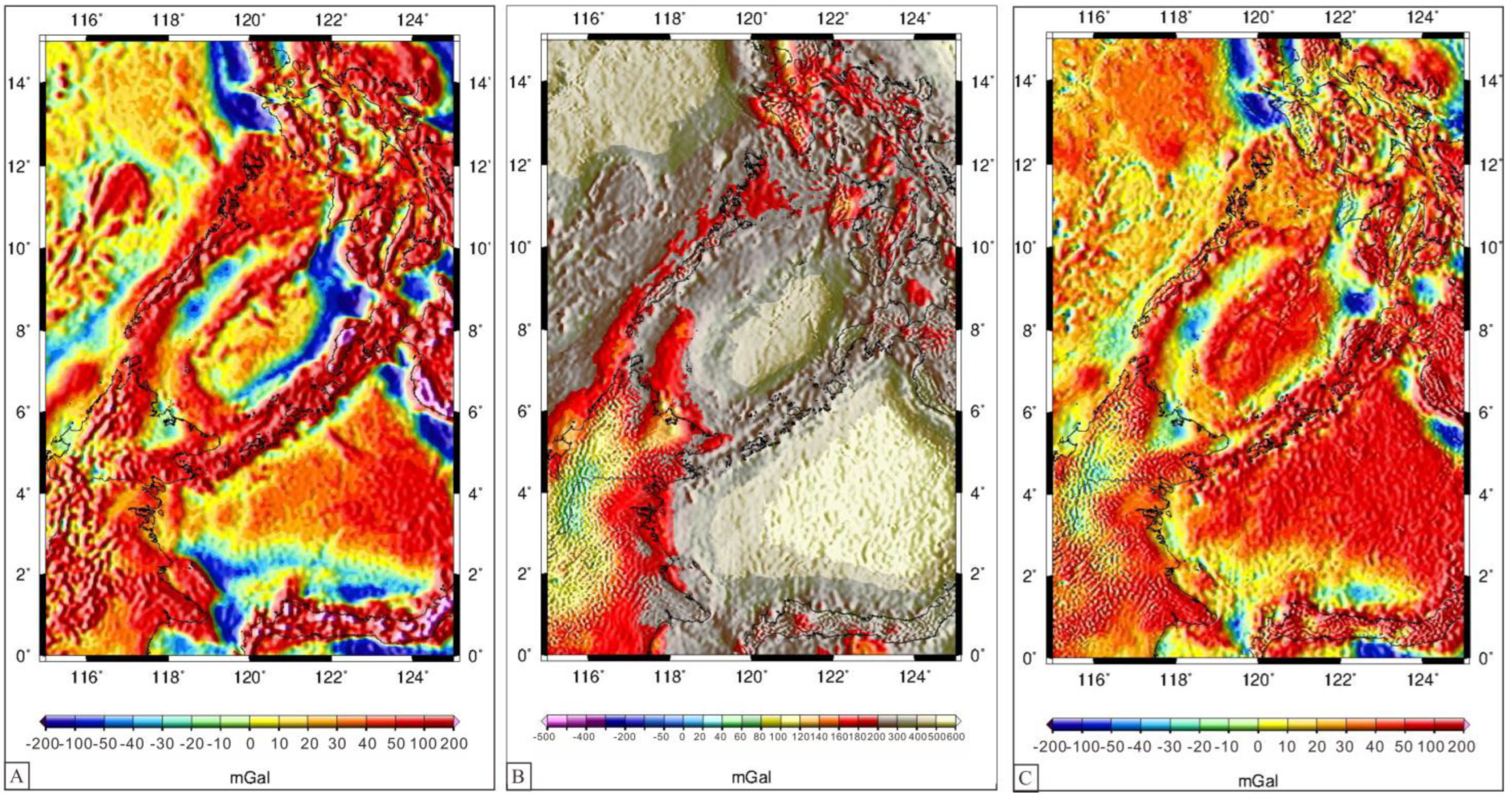

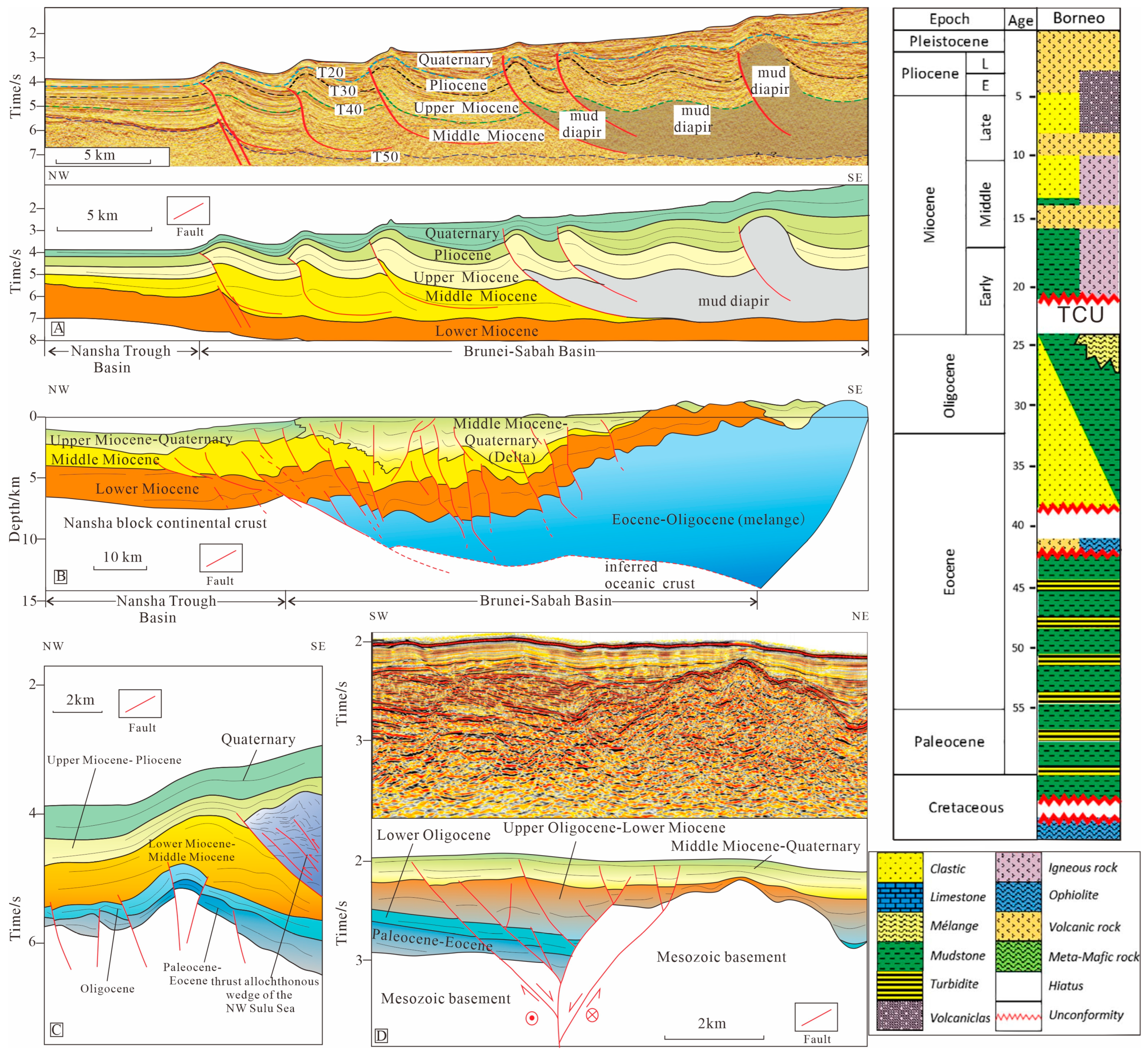
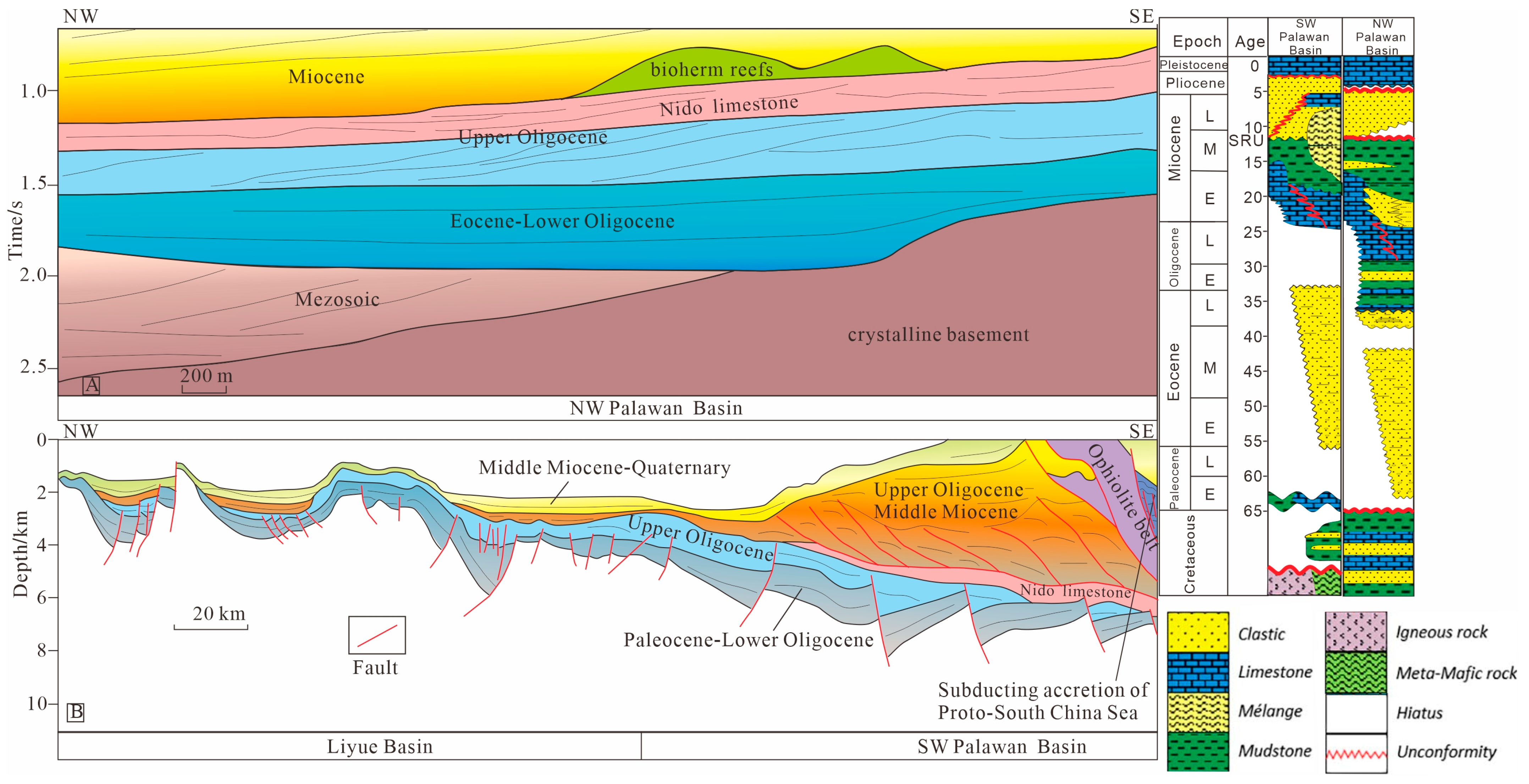
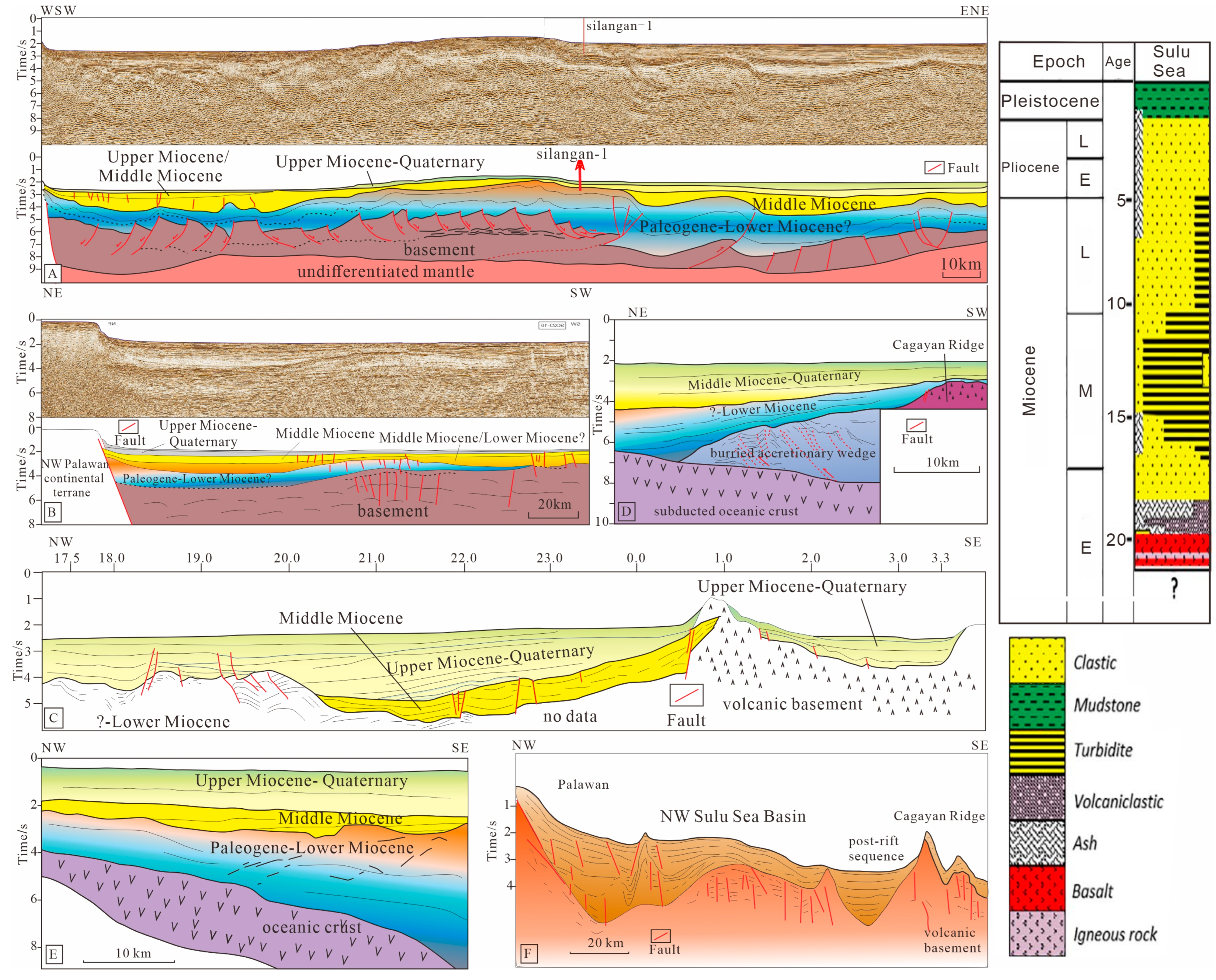


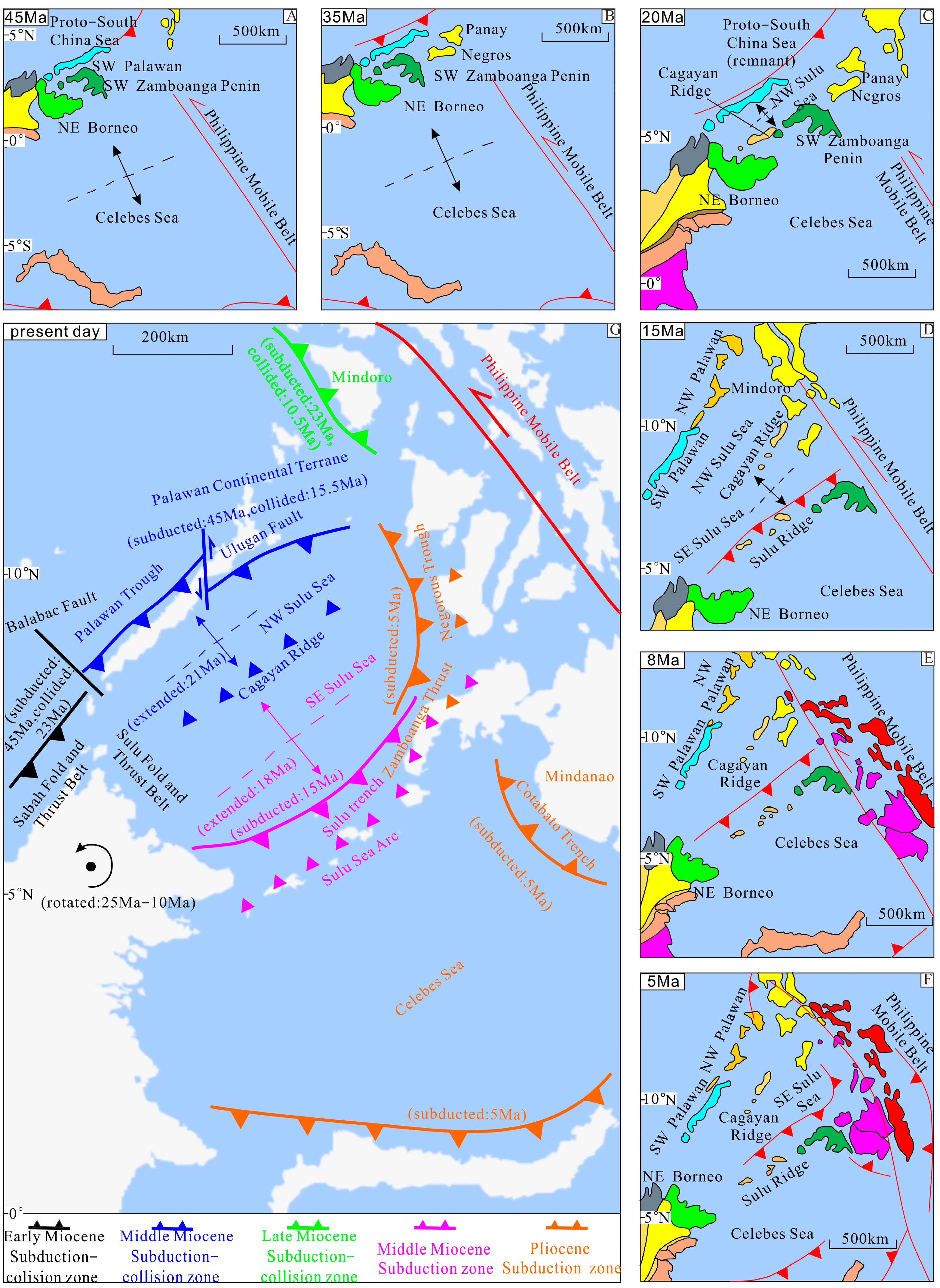
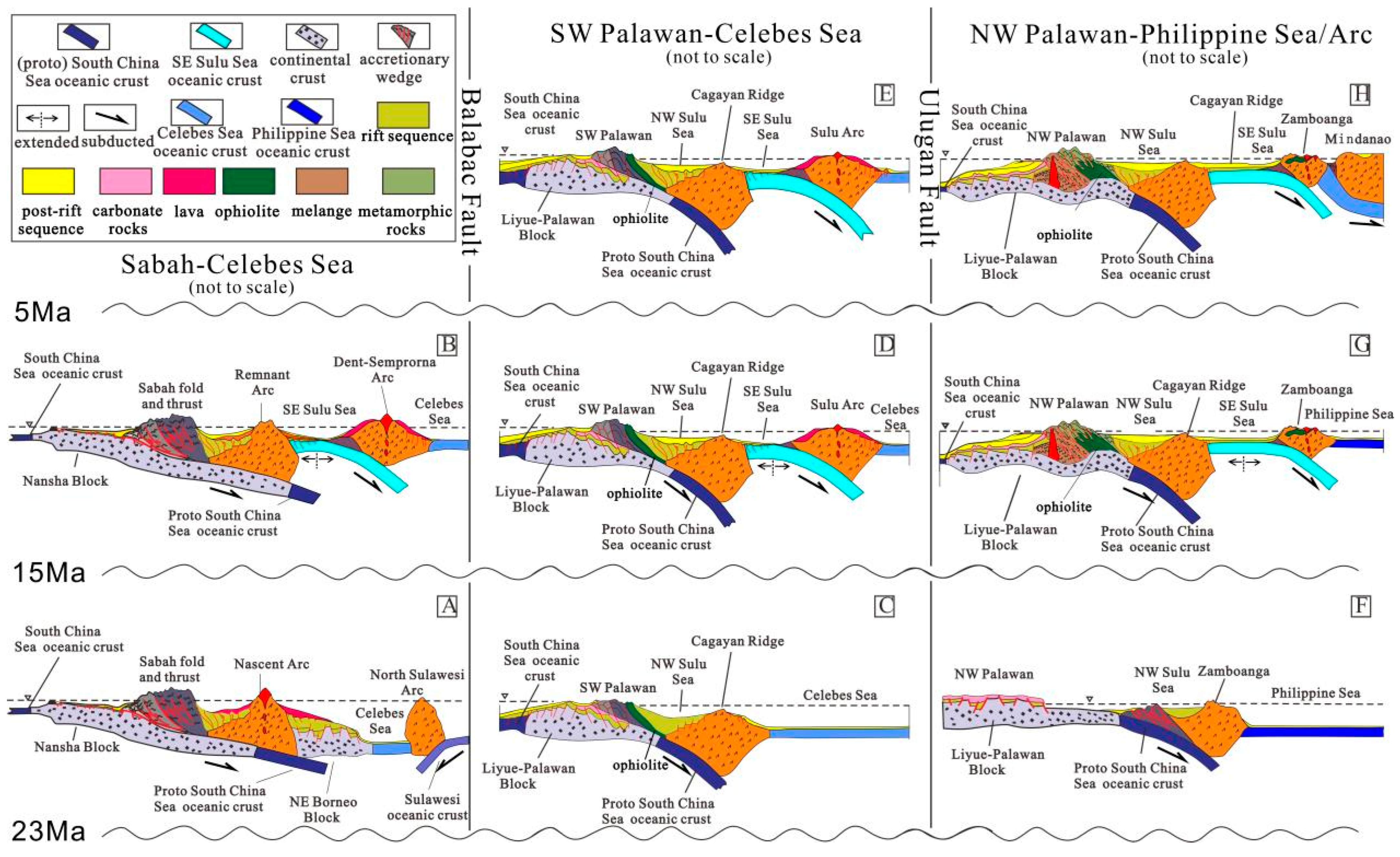
Disclaimer/Publisher’s Note: The statements, opinions and data contained in all publications are solely those of the individual author(s) and contributor(s) and not of MDPI and/or the editor(s). MDPI and/or the editor(s) disclaim responsibility for any injury to people or property resulting from any ideas, methods, instructions or products referred to in the content. |
© 2024 by the authors. Licensee MDPI, Basel, Switzerland. This article is an open access article distributed under the terms and conditions of the Creative Commons Attribution (CC BY) license (https://creativecommons.org/licenses/by/4.0/).
Share and Cite
Yang, Y.; Xie, X.; He, Y.; Chen, H. Opening and Closure of the Sulu Sea: Revealed by Its Peripheral Subduction and Collision Processes. J. Mar. Sci. Eng. 2024, 12, 1456. https://doi.org/10.3390/jmse12081456
Yang Y, Xie X, He Y, Chen H. Opening and Closure of the Sulu Sea: Revealed by Its Peripheral Subduction and Collision Processes. Journal of Marine Science and Engineering. 2024; 12(8):1456. https://doi.org/10.3390/jmse12081456
Chicago/Turabian StyleYang, Yunliu, Xinong Xie, Yunlong He, and Hao Chen. 2024. "Opening and Closure of the Sulu Sea: Revealed by Its Peripheral Subduction and Collision Processes" Journal of Marine Science and Engineering 12, no. 8: 1456. https://doi.org/10.3390/jmse12081456





